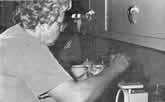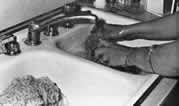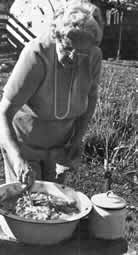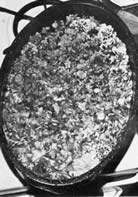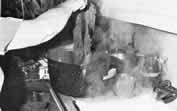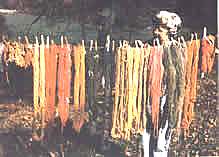
(From BITTERSWEET, Volume II, No. 4, Summer 1975)
by Melissa O'Kelley
The beautiful scenery of the Ozarks has many flowers, barks, leaves and hulls in its vast array of plant life. Early people of this area learned to use these resources as mediums for different colors to tint their clothing which was usually made out of wool. After shearing, carding and spinning their wool, they were ready to dye it so it could be made into usable and attractive clothing.
Some people still spin and dye their own wool for the pure enjoyment of experimenting with the different plants and enjoy creating something like it was done long ago.
In the next pages you will discover the process of dyeing, how to do it, what colors you can expect from certain mordents and plants and how dyeing can be a worthwhile pastime. Elizabeth Fishwick hangs the last skein of wool in the sun to dry at the end of a long day's work dyeing with natural dye materials. Here she is pinning up wool dyed with marigold flowers.
Before actually dyeing the wool, it must be washed thoroughly. To keep the wool from getting tangled up in the wash pan, it should be tied loosely in skeins. You can do this by tying the wool in skeins with a cotton string.
Wool is called "in the grease" when it comes to us directly off the sheep. The dye will not take until this grease or most of it is washed out. To get this lanolin out of the wool it can be washed in any liquid cleaner or mild detergent. Then it should be rinsed clean several times. Any impurity will cause streaking of the dye. The best results are when the dye penetrates evenly.
To make most dyes take to the wool a process called mordanting must be done to the wool. Wool is a natural fiber and repels dye. It has little barbs on each fiber which prevent dye from penetrating. Mordanting is a chemical process which allows the dye to penetrate.
The Indians used a salt solution to achieve this, but the chemicals chrome and alum which can be purchased at drug stores are mostly used today.
ALUM - Alum is the easiest of all the mordants to use. To successfully mordant your work, use the following recipe.
3 oz. potassium aluminum sulfate for fine textured wool or 4 oz. for heavy textured wool 1 oz. cream of tartar 4 gallons water 1 pound of wool
Dissolve the alum in warm water and add to the bath which has been heated to 160°F. Add cream of tartar to produce brighter, clearer colors. The cream of tartar should be dissolved in another pan and added last. Heat the bath at 160°F and add the wet wool. Bring the solution to boiling in half an hour and hold at that point for 3/4th an hour for fine wool and an hour for heavy wool. Wool mordanted with alum may be used for dyeing immediately, washed or not.
CHROME - Chrome is also a mordant that is widely used today and is used to tint the colors darker and deeper. Alum tends to produce lighter colors.
1/2 oz. potassium bichromate 1 oz. cream of tartar 4 gallons water 1 pound of wool
Dissolve chrome in 4 gallons water. Add cream of tartar as in alum. Heat the bath to 160°F and enter the wet and washed wool which has been brought up to the same temperature. Simmer for 1 hour. Keep the wool well covered and allow to cool in mordanting solution. Wool from the chrome bath must be washed out well to remove excess mordanting liquid. It should also be kept in a dark place for there is a chemical reaction to light so that the dye will not take if dried or stored in light.
OTHER MORDANTS - Other mordants such as iron are sometimes used to get more depressed or sad colors. Iron mordant can be made from placing iron nails in vinegar. In two or three months a solution will result that will serve as a mordant. Also using an iron pot to dye in will give the same effect. Iron is generally used toward the end of the dyeing process to sadden colors. It is possible to buy iron salts to use.
Tin mordant on the other hand will give bright, sharp and fast colors, but the chemicals must be used with great care.
You should be very careful when using metallic salts. They should be dissolved and added separately to the bath. Whenever you add additional salts, be sure to remove the wool first.
Throughout the whole dyeing process avoid sudden temperature changes to avoid shrinking the wool. If wool is gradually heated or cooled, it can stand boiling temperatures unharmed.
Using mordants in excess can ruin your wool. Too much alum can make the wool harsh and sticky. Using too much chrome impairs the desired color of the dye. When tin is used in excess, the wool becomes harsh and brittle, and too much iron can streak and harden the wool.
The excess mordanting liquid causes "color lakes" being formed on the wool which will result in the color rubbing off.
To prevent uneven oxidation while mordanting, use a smooth paddle to keep the wool under the water at all times to prevent dark streaks and even color. But while mordanting or dyeing, do not stir for that will tangle the skeins.
You can use this bath again and some say a standing bath is better than a fresh bath. Mordants can be made ahead of time and stored in glass containers indefinitely.
Do not put wool mordanted with alum and that mordanted with chrome in the batch of dye at the same time.
After mordanting, the wool is ready for dyeing. You will need a large kettle or some kind of container of glass, granite or enamel for each color you are dyeing. For clear colors an enamel or glass container is better.
Soft rainwater is the best water that can be used for dyeing. If the water is hard, add a little ascetic acid to soften it.
You will also need a large paddle or other tool to remove the skeins and keep them covered in the bath.
DYEING HINTS - There are several things to keep in mind while dyeing. The dye bath should be very warm when entering the wool and you should raise the temperature steadily to simmering. The longer you leave the wool in the dye bath the deeper the colors, but do not boil wool hard or long for it tends to take the life out of it. Just keep it simmering.
One tip to remember when dyeing is to be sure your yarn floats in the bath. This will insure even access of the dye to all parts of the skein.
Be sure to avoid sudden temperature change. After the wool had been entered in the bath, be sure it is well spread out so it will dye evenly and do not crowd the container for best results. After dyeing, rinse well with increasingly cooler water to remove all loose dye. Rinse until water is clear.
Weigh all chemicals carefully. Use great care in using chemicals.
Above: Wool should be washed carefully and thoroughly to remove all the lanolin and dirt before dyeing. This foreign matter will keep wool from dyeing evenly. Below: Rinse wool through several waters.
Some people prefer to dry in the sun to brighten the color. For that reason some do not like to dye on a cloudy day.
Some natural dyes, like mullein and onions give off quite an unpleasant odor, so you may prefer to do your dyeing out of doors.
There are many natural materials in the Ozarks that can be used for dyeing. Some that we have used are sassafras roots and bark, wild cherry bark, mullein leaves, flowers of goldenrod and marigolds, sumac berries and walnut hulls. There are many other mediums for dye, using many different parts of the plant. Once you get interested you can experiment to find pleasing and interesting colors.
Elizabeth prefers to prepare some dyes outside, especially onions.
Most natural dyes found in the Ozarks are yellow or browns. A display of wools dyed with natural dyes remind one of the Ozark fall colors--mostly muted shades of yellow, orange and browns.
If you are interested, you may want to experiment with different plants to see what colors you can get, but be sure to get a lot of plant material if you wish to dye very much wool, for it takes a large quantity to extract enough color to dye.
The general basic instructions are
to boil the plant material to extract the color, then add the wet mordanted wool which has been brought up to the temperature of the dye bath. Following are a few recipes we have tried under the leadership and help of Elizabeth Fishwick.
Onions
Alum - deep clear yellow Chrome - rich copper
1 pound onion skins or whole onions 1 pound mordanted wool Plentiful amount of soft water
Boil onions or onion skins for 1 to 1 1/2 hours. You can put wool into dye bath with onions still in the pan, or you can use only the liquid. Boil for 1 hour.
Adding copperas 15 minutes before removal time will sadden the color and give a brassy yellow orange. Adding a few grains of tin will also give an orange color. Both the yellow and red onions will yield a yellowish gold color.
Onions mordanted with chrome was our favorite of all the colors we dyed.
You may want to boil the onions outside to avoid the strong odor.
Goldenrod
Alum - yellow Chrome - Brass
11/2 quarts of dried flower heads or 11/2 pecks fresh flower heads 1 pound mordanted wool water
Simmer flower heads for 2 or 3 hours. Enter wet mordanted wool and heat until desired color is reached. Goldenrod gives the best color for dyeing when it first begins to bloom.
Goldenrod blossoms and stems cooked in a large enamel pan for two to three hours give a bright yellow dye. It can be topped with indigo to produce green.
Marigolds
Alum - yellow green Chrome - orange
1 quart to 1 1/2 bushels of flower heads or whole stalks 1 pound mordanted wool water
Boil flower heads about 15 minutes. Strain or leave flower heads in the bath. Keep wool in the bath until desired color is reached. The yellow color which is obtained with alum will work well with an indigo top bath to make shades of green.
Mullein
Alum - yellow, slightly greenish Chrome - darker shades of this
Large pan of green leaves 1 pound mordanted wool Plentiful amount of water
Boil, leaves for about 2 hours. Strain. Enter wet wool and simmer about 1 hour. Like the onions you may want to prepare this outside because of the odor which reminded us of a wet barnyard.
Black Walnut Hulls Color - shades of brown 1/2 peck green walnut hulls 1 pound un-mordanted wool Plentiful amount of water
Boil hulls 2 1/2 hours. Strain and return liquid back to same pan. Add enough water to make 4 gallons. Enter wet wool and simmer for 30 minutes. Rinse until water is clean and hang in the sun to dry.
Depending on the amount of hulls used you can get various shades of brown up to a deep rich brown and almost black. Be sure to keep the wool under the water at all times to insure even dyeing.
Wild Cherry
Color - soft, warm, almost orangish beige
pan full of bark or roots 1 pound mordanted wool water
Boil the roots or bark for at least 1 hour. Strain the liquid. Enter wet wool and simmer for an hour or until desired color is arrived at.
Fresh and dried marigold blossoms boiled together make a beautiful yellow dye.
Sumac
Alum - beige Chrome - darker beige
1/2 peck ripe sumac berries 1 tsp. copperas 1 pound mordanted wool Generous amount of water
Soak berries 1 hour. Boil for 30 minutes. Strain berries and return the ooze to the kettle. Add water until you have a generous dye bath. Add copperas and mix well.
When bath is hot, add wet and washed wool and keep the water a simmering boil for 1/2 hour. Rinse wool until water is clear.
Sassafras
Alum - light brown or tan Chrome - pinkish shades of brown
1/2 pound dry bark or roots 1 pound mordanted wool Soft water
Boil bark or roots about 2 1/2 hours. Strain material out and add enough water to fill container. Enter wet wool. Simmer for at least an hour or until desired color is reached.
The two following recipes do not use native Ozark dyestuffs, though they are natural. Since there are not any natural reds or blues in native plant material, to round out the colors, most home dyers purchase indigo and cochineal.
Indigo
Color - blue
4 1/2 ounce powdered indigo 3 ounces sodium hydroxide 2 3/4 ounce sodium hydrosulphite 1 pound un-mordanted wool water
Be sure to measure all chemicals carefully, weighing accurately. Mix the powdered indigo with sodium hydroxide which has been dissolved in water. Add enough water to make 1 gallon of liquid and heat to 120°F. Stir well and add the sodium hydrosulphite slowly. Let this stand for 30 minutes. The liquid should be clear and yellow and should be stored in a stoppered bottle.
Indigo is very strong and should be used sparingly. Remove the wool and rinse clean.
To make different shades of green you can use indigo as a top dye on wool dyed with mullein, onion skins, marigold and other yellow dyes.
Cochineal
Color - red
1 1/2 ounce cochineal 1 1/2 ounce cream of tartar 1/4 tsp. stannous chloride 1 pound mordanted wool water
Soak the cochineal for 30 minutes. Strain this and add to the dye bath. Add enough water to fill your container. Add cream of tartar and stannous chloride. Let this dissolve and heat the mixture. Enter mordanted wool and simmer for 30 minutes. Rinse wool thoroughly. Hang in the sun to dry.
Cochineal is a cactus feeding insect found near the Mexican border. It can be used ground or whole.
When removing the dyed skeins from the boiling pan of water, carefully put them into clean water of the same temperature Then gradually reduce water temperature as you rinse.
Photography by staff
